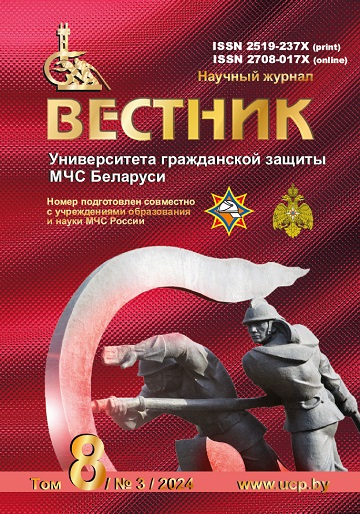Исследование изменения динамической твердости гипсовых плит, обусловленного тепловым воздействием пожара
DOI:
https://doi.org/10.33408/2519-237X.2024.8-3.253Ключевые слова:
осмотр места пожара, гипсовая плита, термическое повреждение, ударно-импульсный метод, очаг пожараАннотация
Цель. Определить изменение динамической твердости гипсовых плит, обусловленное воздействием высоких температур, для установления применимости динамического индентирования конструкций, выполненных из данного материала, для проведения оценки степени полученных в условиях пожара термических повреждений.
Методы. Натурные огневые испытания гипсовых плит. Динамическое индентирование.
Результаты. Подтверждена возможность оценки изменения динамической твердости гипсовых плит, обусловленного воздействием повышенной температуры во время пожара, с применением метода динамического индентирования. На основании проведенных огневых испытаний каркасно-обшивной перегородки, выполненной из гипсовой плиты типа Н на стальном каркасе, приведены результаты определения изменения динамической твердости гипсовой плиты указанного типа. Помимо максимальной температуры на поверхности гипсовой плиты, значительное влияние на изменение глубины вдавливания инденторов оказывает время нагрева. Установлено, что на различных участках поверхности материала при значениях максимальных (120–130 °С) и средних (104–115 °С) температур при отличающемся времени нагрева значение глубины вдавливания индентора отличается в 1,5–2,0 раза.
Область применения исследований. Полученные результаты исследований могут быть применены при разработке методики установления очага пожара по степени термических поражений конструкций, выполненных с использованием гипсовых плит.
Библиографические ссылки
Megorskiy B.V. Metodika ustanovleniya prichin pozharov [Methodology for identifying the causes of fires]. Moscow: Stroyizdat, 1966. 347 p. (rus).
Cheshko I.D. Tekhnicheskie osnovy rassledovaniya pozharov [Technical basics of fire investigation]: tutorial. Moscow: VNIIPO, 2002. 330 p. (rus).
Surikov A.V., Zaynudinova N.V., Boyko V.P. Perspektivnye metody otsenki stepeni poluchennykh v usloviyakh pozhara termicheskikh povrezhdeniy konstruktsiy, vypolnennykh s primeneniem gipsovykh plit [Promising methods for assessing the degree of thermal damage obtained under fire conditions made with the application of gypsum boards]. Journal of Civil Protection, 2022. Vol.6, No. 4. Pp. 400–414. (rus). DOI: https://doi.org/10.33408/2519-237X.2022.6-4.400. EDN: https://elibrary.ru/ZYWQWU.
Surikov A.V., Zaynudinova N.V., Boyko V.P., Garaev Yu.V. Otsenka vozmozhnosti primeneniya dinamicheskogo indentirovaniya gipsovykh plit dlya ustanovleniya stepeni poluchennykh v usloviyakh pozhara termicheskikh porazheniy konstruktsiy [Evaluation of the possibility of using dynamic indentation of gypsum boards to determine the degree of thermal damage to structures received under fire conditions]. Journal of Civil Protection, 2023. Vol.7, No. 2. Pp. 164–177. (rus). DOI: https://doi.org/10.33408/2519-237X.2023.7-2.164. EDN: https://elibrary.ru/KWSHQS.
Gorbett G.E., Morris S.M., Meacham B.J., Wood C.B. A new method for the characterization of the degree of fire damage to gypsum wallboard for use in fire investigations. Journal of Forensic Sciences, 2015. Vol. 60, Iss. s1. Pp. 193–196. DOI: https://doi.org/10.1111/1556-4029.12616.
Volosach A.V., Gorovykh O.G. Rezul'taty eksperimental'nykh issledovaniy poverkhnostnoy tverdosti yacheistykh betonov, podvergshikhsya temperaturnomu vozdeystviyu, indentorami s uglami rastvora konusa 20–55° [Results of experimental researches of surface hardness of cellular concretes exposed to temperature by indentors having 20–55° angles of cone opening]. Journal of Civil Protection, 2019. Vol. 3, No. 1. Pp. 13–22. (rus). DOI: https://doi.org/10.33408/2519-237X.2019.3-1.13. EDN: https://elibrary.ru/YZVGBF.
Опубликован
Как цитировать
Лицензия
Все права защищены (c) 2024 Суриков А.В., Зайнудинова Н.В., Гараев Ю.В.

Это произведение доступно по лицензии Creative Commons «Attribution-NonCommercial» («Атрибуция — Некоммерческое использование») 4.0 Всемирная.




















